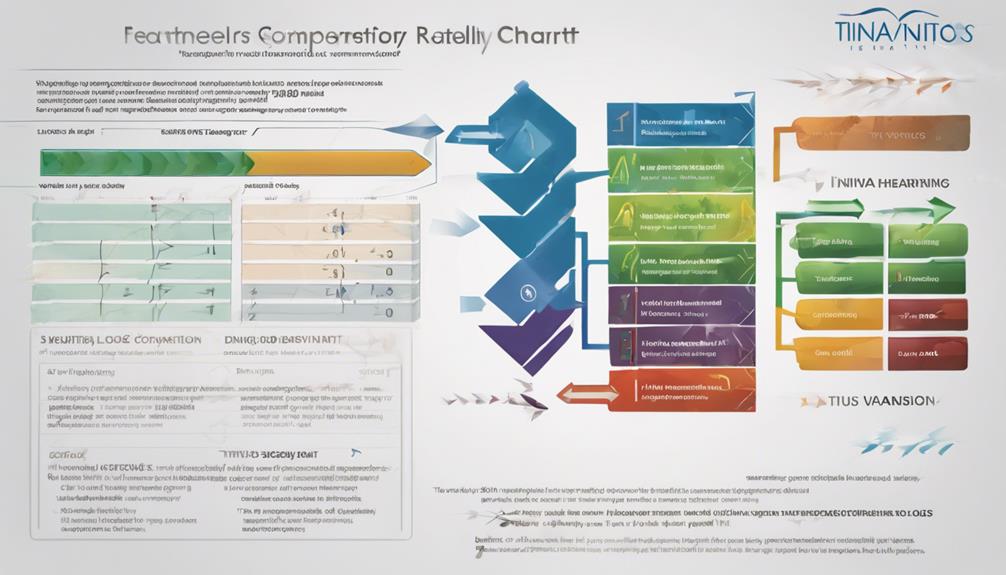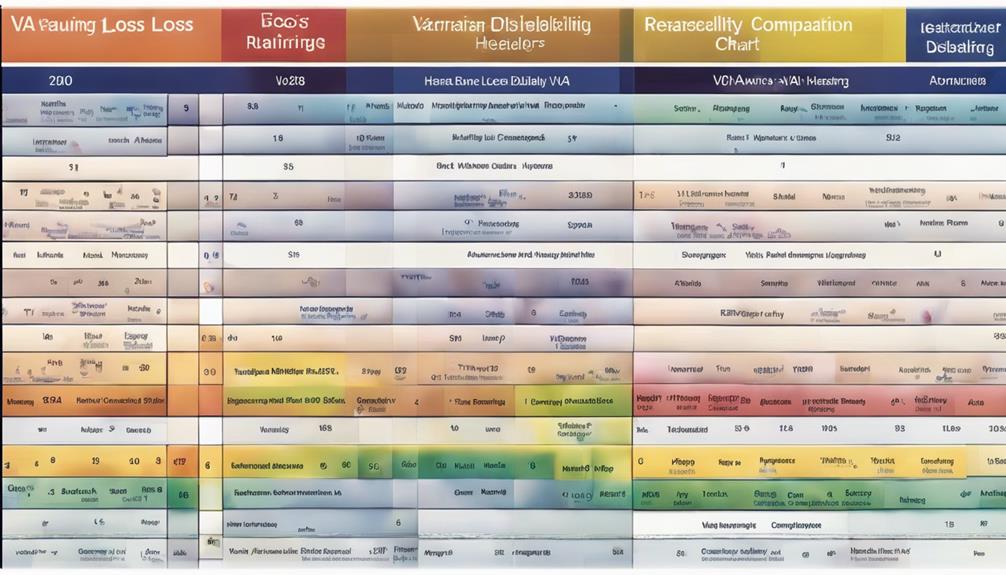Understanding the VA Hearing Loss Rating Chart is essential for gaining valuable insights into disability compensation for veterans facing hearing impairments.
As we navigate the intricacies of the rating system, we uncover crucial details that impact the compensation veterans receive.
From the initial evaluations to the final ratings, each step holds significance in determining the support available to those who have served our country.
With a deeper grasp of this process, we can better advocate for those who have sacrificed for our nation.
Key Takeaways
- VA disability ratings from 0% to 100% determine compensation levels.
- Speech discrimination and puretone thresholds are critical in rating assessments.
- Secondary conditions like tinnitus can impact disability ratings.
- Understanding VA C&P exam tests is essential for accurate preparation.
VA Hearing Loss Rating Chart Overview
The VA Hearing Loss Rating Chart serves as a critical tool in determining disability compensation for veterans based on the severity of their hearing impairment. This chart, used by the VA, assigns ratings ranging from 0% to 100% depending on the level of hearing loss and speech discrimination. It assists VA assessors in accurately evaluating the extent of a veteran's hearing impairment and determining the appropriate compensation they deserve.
Specific thresholds in decibels and speech discrimination scores are key factors in placing individuals on the rating chart. Understanding this chart is essential for veterans navigating the process of seeking disability benefits for their hearing impairment. By utilizing this assessment tool, the VA ensures that veterans receive fair compensation that aligns with the severity of their condition, thus acknowledging and supporting their service-related disabilities effectively.
This comprehensive assessment allows for a detailed and precise evaluation, enabling veterans to access the compensation they rightly deserve.
Determining Disability Compensation Criteria

When determining disability compensation criteria for hearing loss, evaluators consider the severity of impairment, speech discrimination scores, and puretone threshold results. To understand the process better, here are three key points to keep in mind:
- Severity of Impairment: The extent of hearing loss plays a significant role in determining disability compensation. Evaluators assess how much the impairment affects an individual's ability to hear and communicate effectively.
- Speech Discrimination Scores: These scores measure an individual's ability to understand speech in noisy environments. Lower scores indicate greater difficulty in discerning words, which can impact the overall disability rating.
- Puretone Threshold Results: Puretone audiometry tests help determine the softest sounds a person can hear at different frequencies. These results are crucial in assessing the degree of hearing loss and assigning the appropriate disability rating percentage.
Understanding these factors is essential in navigating the VA criteria for disability compensation, as they directly influence the benefits and compensation veterans receive for their hearing loss.
Interpreting VA Disability Compensation Ratings
Navigating the VA Disability Compensation system requires a thorough understanding of how impairment ratings ranging from 0% to 100% are utilized to determine the compensation level for hearing loss. The VA Disability Compensation ratings are crucial in determining the benefits veterans receive based on the severity of their hearing loss. The impairment rating percentage chart serves as a guide to establish the level of disability compensation a veteran is entitled to. Placement on the grid reflects the combined effect of hearing loss in both ears. Legal assistance can be invaluable in comprehending the VA system and ensuring fair compensation for hearing loss. Veterans must grasp the nuances of disability ratings to ensure they receive the appropriate benefits they deserve.
| Disability Rating | Compensation Rating |
|---|---|
| 0% to 10% | No compensation |
| 20% | Some compensation |
| 30% to 60% | Moderate compensation |
| 70% to 100% | Significant compensation |
Understanding Secondary Conditions Impact

Understanding the impact of secondary conditions on disability compensation ratings is essential for veterans navigating the VA system. When it comes to hearing loss, secondary conditions such as tinnitus or balance issues can significantly influence the overall disability compensation rating. Here are three key points to consider:
- Functional Limitations: Secondary conditions can exacerbate the functional limitations experienced by individuals with hearing loss, affecting their daily lives and overall well-being.
- Combined Effects: The VA takes into account the combined effects of both primary and secondary conditions when determining disability ratings, recognizing the holistic impact on the individual.
- Medical Evidence and Connection: Establishing a clear connection between secondary conditions and the primary hearing loss may require additional medical evidence and documentation to support the claim effectively.
Comprehending how secondary conditions contribute to the overall disability picture is paramount for veterans seeking to maximize their VA benefits and ensure they receive the compensation they deserve.
Preparing for VA C&P Exams
To prepare effectively for VA C&P exams related to hearing loss, it is essential to understand the specific tests involved and provide accurate information regarding symptoms of hearing impairment. VA C&P exams usually consist of speech discrimination and puretone audiometry tests, which play a crucial role in determining the disability rating for hearing loss. During these exams, hearing aids are typically not used to ensure an accurate assessment of hearing impairment. The results obtained from these exams are fundamental in calculating the impairment rating percentage for VA disability compensation. Therefore, preparation for VA C&P exams should focus on familiarizing oneself with these tests and ensuring that accurate details about hearing loss symptoms are communicated. Below is a table highlighting key aspects to consider when preparing for VA C&P exams:
| Aspect | Importance | Action Required |
|---|---|---|
| Understanding Test Procedures | High | Study speech discrimination and puretone audiometry. |
| Providing Accurate Information | Critical | Describe hearing loss symptoms accurately. |
| Avoiding Hearing Aids | Essential | Do not use hearing aids during the exams. |
Frequently Asked Questions
What Amount of Hearing Loss Qualifies for VA Disability?
We qualify for VA disability compensation if our hearing loss is at least 10%. The severity is determined through audiometric tests.
VA uses a rating schedule to assign disability percentages based on hearing loss levels. Varying levels of impairment correspond to different disability ratings.
VA compensates veterans according to their hearing loss extent, as defined by VA rating criteria.
Is the DAV Good for VA Claims?
Yes, the Disabled American Veterans (DAV) is excellent for VA claims. We've firsthand experience working with DAV service officers who provide invaluable assistance in navigating the VA claims process.
They've a proven track record of success in securing disability benefits for veterans, resulting in higher ratings and faster resolutions.
Utilizing DAV services can significantly increase the chances of a successful VA claim, particularly for complex cases such as hearing loss or tinnitus.
Can You Claim Hearing Loss Secondary to Tinnitus?
We've got your back!
Yes, you can claim hearing loss as secondary to tinnitus. Establishing a clear link between the two is crucial for a successful claim. Medical evidence showing how tinnitus exacerbates hearing loss will strengthen your case. Consider consulting a healthcare provider to understand this connection better.
VA may grant a secondary service connection for hearing loss if it's related to tinnitus. Let's work together to navigate this process successfully.
What Is a 4.85 Evaluation of Hearing Impairment?
A 4.85 evaluation of hearing impairment represents a specific level on the VA impairment rating grid. It indicates the extent of disability in hearing loss based on audiometric test results.
This evaluation is critical in determining the percentage of disability compensation a veteran may receive. Understanding the significance of a 4.85 rating is essential for veterans applying for VA disability benefits related to hearing impairment.
It plays a crucial role in determining the financial support available to veterans with hearing loss.
Conclusion
As we navigate the intricate web of VA disability ratings, let's remember that each percentage point on the hearing loss chart represents a piece of our story. Like a symphony, our struggles and triumphs harmonize to create a unique melody of resilience.
Let's embrace the journey ahead with courage and determination, knowing that our voices, though altered, still carry the power to inspire and uplift.











